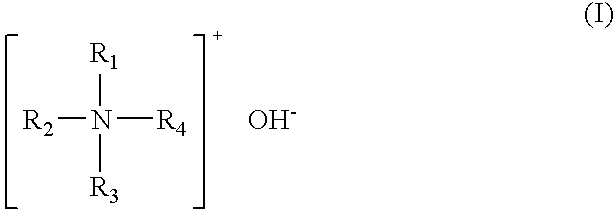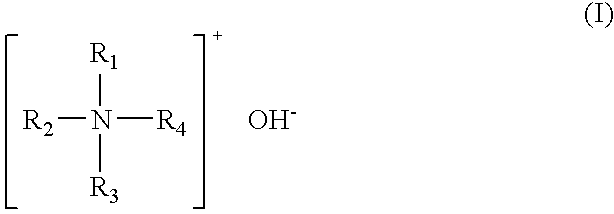Cleaning liquid used in photolithography and a method for treating substrate therewith
a cleaning liquid and photolithography technology, applied in the field of photolithography cleaning liquid and a method for treating substrate therewith, can solve the problems of affecting the shape and affecting the effect of the photoresist pattern made of the negative-working photoresist material,
- Summary
- Abstract
- Description
- Claims
- Application Information
AI Technical Summary
Benefits of technology
Problems solved by technology
Method used
Image
Examples
examples
[0043]The invention will be hereunder described in detail with reference to the following Examples, but it should not be construed that the invention is limited thereto. All compounding amounts are mass % unless otherwise indicated.
[Preparation of Cleaning Liquid]
[0044]Cleaning liquids as shown in Table 1 were prepared.
TABLE 1Components (mass %)ComponentComponentComponentOther(a)(b)(c)componentsCleaningTPAH (2)DMSO (95) (3)—liquid 1CleaningTPAH (2)DMSO (75) + (3)—liquid 2SLF (20)CleaningTPAH (2)DMSO (75) + (3)—liquid 3NMP (20)CleaningMTPAH (2)DMSO (95) (3)—liquid 4CleaningTBAH (5)DMSO (50) +(30)—liquid 5SLF (15)CleaningTBAH (5)DMSO (65) +(15)—liquid 6NMP (15)CleaningMTBAH (5)DMSO (45) +(20)—liquid 7NMP (30)Comparative—DMSO (95) (3)TMAH (2)cleaningliquid 1ComparativeTPAH (0.4)DMSO (99) (0.6)—cleaningliquid 2ComparativeTPAH (10)DMSO (50)(40)—cleaningliquid 3Comparative—DMSO (80) (9.76)TMAHcleaning(0.24),liquid 4MEA (10)Comparative—DMSO (98) (1.5)TMAH (0.5)cleaningliquid 5Comparative—D...
PUM
| Property | Measurement | Unit |
|---|---|---|
| thickness | aaaaa | aaaaa |
| height | aaaaa | aaaaa |
| mass % | aaaaa | aaaaa |
Abstract
Description
Claims
Application Information
 Login to View More
Login to View More - R&D
- Intellectual Property
- Life Sciences
- Materials
- Tech Scout
- Unparalleled Data Quality
- Higher Quality Content
- 60% Fewer Hallucinations
Browse by: Latest US Patents, China's latest patents, Technical Efficacy Thesaurus, Application Domain, Technology Topic, Popular Technical Reports.
© 2025 PatSnap. All rights reserved.Legal|Privacy policy|Modern Slavery Act Transparency Statement|Sitemap|About US| Contact US: help@patsnap.com



